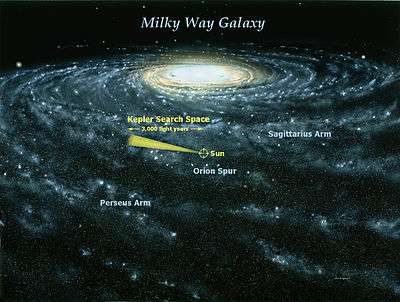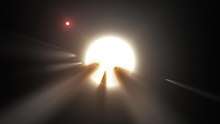Kepler-432
Kepler-432 is a binary star system with at least two planets in orbit around the primary companion, located about 2,830 light-years away from Earth.
| Observation data Epoch J2000 Equinox J2000 | |
|---|---|
| Constellation | Cygnus |
| Right ascension | {{{ra}}} |
| Declination | +48° 17′ 09.1454″[1] |
| Apparent magnitude (V) | 13 |
| Characteristics | |
| Evolutionary stage | Giant star / Main sequence |
| Spectral type | K2III[2] / M?V[3] |
| Astrometry | |
| Proper motion (μ) | RA: 4.531±0.045[1] mas/yr Dec.: 10.120±0.044[1] mas/yr |
| Parallax (π) | 1.1509 ± 0.0278[1] mas |
| Distance | 2,830 ± 70 ly (870 ± 20 pc) |
| Orbit | |
| Primary | Kepler-432 A |
| Companion | Kepler-432 B |
| Period (P) | 15,000 yr |
| Details[3] | |
| Kepler-432 A | |
| Mass | 1.32+0.10 −0.07 M☉ |
| Radius | 4.06+0.12 −0.08 R☉ |
| Luminosity | 9.206 ± 0.01 L☉ |
| Surface gravity (log g) | 3.345 ± 0.006 cgs |
| Temperature | 4995 ± 78 K |
| Metallicity [Fe/H] | 0.176 ± 0.07 dex |
| Rotational velocity (v sin i) | 2.7 ± 0.5 km/s |
| Age | 4.2+0.8 −1.0 Gyr |
| Kepler-432 B | |
| Mass | ~0.52 M☉ |
| Temperature | ~3660 K |
| Age | 4.2? Gyr |
| Position (relative to Kepler-432 A)[3] | |
| Component | Kepler-432 B |
| Observed separation (projected) | ~750 AU [3] |
| Other designations | |
| Database references | |
| SIMBAD | data |
| KIC | data |
Nomenclature and history

Prior to Kepler observation, Kepler-432 had the 2MASS catalogue number 2MASS J19330772+4817092. In the Kepler Input Catalog it has the designation of KIC 10864656, and when it was found to have transiting planet candidates it was given the Kepler object of interest number of KOI-1299.
Planetary candidates were detected around the star by NASA's Kepler Mission, a mission tasked with discovering planets in transit around their stars. The transit method that Kepler uses involves detecting dips in brightness in stars. These dips in brightness can be interpreted as planets whose orbits pass in front of their stars from the perspective of Earth, although other phenomenon can also be responsible which is why the term planetary candidate is used.[4]
Following the acceptance of the discovery paper, the Kepler team provided an additional moniker for the system of "Kepler-432".[5] The discoverers referred to the star as Kepler-432, which is the normal procedure for naming the exoplanets discovered by the spacecraft.[2] Hence, this is the name used by the public to refer to the star and its planet.
Candidate planets that are associated with stars studied by the Kepler Mission are assigned the designations ".01", ".02" etc. after the star's name, in the order of discovery.[6] If planet candidates are detected simultaneously, then the ordering follows the order of orbital periods from shortest to longest.[6] Following these rules, there was two candidate planets detected, with orbital periods of 52.501129 and 406.2 days.
The designation b and c derive from the order of discovery. The designation of b is given to the first planet orbiting a given star, and c to the farthest.[7] In the case of Kepler-432, there was initially two detected, so the letters b and c are used. The planets are more commonly referred to without the "A" designation, although sometimes the full designation is used.
Stellar characteristics
Kepler-432 is a binary star system composed of a K-type giant star (Kepler-432 A) and a red dwarf star (Kepler-432 B).
The apparent magnitude of the system, or how bright it appears from Earth's perspective, is about 15.8. Therefore, it is too dim to be seen with the naked eye.
Kepler-432 A
Kepler-432 A is a K-type giant star. It has exhausted the hydrogen in its core and has begun expanding into a red giant.[3] The star has a mass and radius 132% and 406% that of the Sun. It has a temperature of 4995 K and is 4.2 billion years old. In comparison, the Sun is about 4.6 billion years old[8] and has a temperature of 5778 K.[9]
The primary star is metal-rich, with a metallicity ([Fe/H]) of about 0.17, or about 147% of the amount of iron and other heavier metals found in the Sun.[3] Its luminosity is typical for an evolving giant star like Kepler-432, with a luminosity about 9.3 times the solar luminosity.[3]
The apparent magnitude of the system, or how bright it appears from Earth's perspective, is about 15.8. Therefore, it is too dim to be seen with the naked eye.
Planetary system
| Companion (in order from star) |
Mass | Semimajor axis (AU) |
Orbital period (days) |
Eccentricity | Inclination | Radius |
|---|---|---|---|---|---|---|
| b | 5.41+0.32 −0.8 MJ |
0.301 ± 0.014 | 52.501129 | 0.5134 ± 0.01 | 88.17+0.61 −0.33° |
1.45 ± 0.039 RJ |
| c | 2.43+0.22 −0.24 MJ |
1.1? | 406.2+3.9 −2.5 |
— | — | — |
The primary companion is known to host 2 giant planets, both more massive then Jupiter. The innermost planet, Kepler-432b, is interacting with its star and is slowly spiraling inwards towards its star as a result of tidal interaction.[2] It will probably be devoured by its star as it expands past the orbit of planet b. The outermost planet was only detected through radial velocity and hence only its mass is known.[3]
References
- Brown, A. G. A.; et al. (Gaia collaboration) (August 2018). "Gaia Data Release 2: Summary of the contents and survey properties". Astronomy & Astrophysics. 616. A1. arXiv:1804.09365. Bibcode:2018A&A...616A...1G. doi:10.1051/0004-6361/201833051. Gaia DR2 record for this source at VizieR.
- Ortiz, Mauricio; Gandolfi, Davide; Reffert, Sabine; Quirrenbach, Andreas; Deeg, Hans J.; Karjalainen, Raine; Montañes-Rodríguez, Pilar; Nespral, David; Nowak, Grzegorz; Osorio, Yeisson; Palle, Enric (2015). "Kepler-432 b: A massive warm Jupiter in a 52-day eccentric orbit transiting a giant star". Astronomy & Astrophysics. 573 (6): L6. arXiv:1410.3000. Bibcode:2015A&A...573L...6O. doi:10.1051/0004-6361/201425146.
- Quinn, Samuel N.; White, Timothy R.; Latham, David W.; Chaplin, William J.; Handberg, Rasmus; Huber, Daniel; Kipping, David M.; Payne, Matthew J.; Jiang, Chen; Victor Silva Aguirre; Stello, Dennis; Sliski, David H.; Ciardi, David R.; Buchhave, Lars A.; Bedding, Timothy R.; Davies, Guy R.; Hekker, Saskia; Kjeldsen, Hans; Everett, Mark E.; Howell, Steve B.; Basu, Sarbani; Campante, Tiago L.; Christensen-Dalsgaard, Jørgen; Elsworth, Yvonne P.; Karoff, Christoffer; Kawaler, Steven D.; Lund, Mikkel N.; Lundkvist, Mia; Esquerdo, Gilbert A.; et al. (2014). "Kepler-432: A red giant interacting with one of its two long period giant planets". The Astrophysical Journal. 803 (2): 49. arXiv:1411.4666. Bibcode:2015ApJ...803...49Q. doi:10.1088/0004-637X/803/2/49.
- Morton, Timothy; Johnson, John (23 August 2011). "On the Low False Positive Probabilities of Kepler Planet Candidates". The Astrophysical Journal. 738 (2): 170. arXiv:1101.5630. Bibcode:2011ApJ...738..170M. doi:10.1088/0004-637X/738/2/170.
- NASA (27 January 2014). "Kepler – Discoveries – Summary Table". NASA. Retrieved 1 March 2014.
- "Kepler Input Catalog search result". Space Telescope Science Institute. Retrieved 25 July 2015.
- Hessman, F. V.; Dhillon, V. S.; Winget, D. E.; Schreiber, M. R.; Horne, K.; Marsh, T. R.; Guenther, E.; Schwope, A.; Heber, U. (2010). "On the naming convention used for multiple star systems and extrasolar planets". arXiv:1012.0707 [astro-ph.SR].
- Fraser Cain (16 September 2008). "How Old is the Sun?". Universe Today. Retrieved 19 February 2011.
- Fraser Cain (September 15, 2008). "Temperature of the Sun". Universe Today. Retrieved 19 February 2011.


